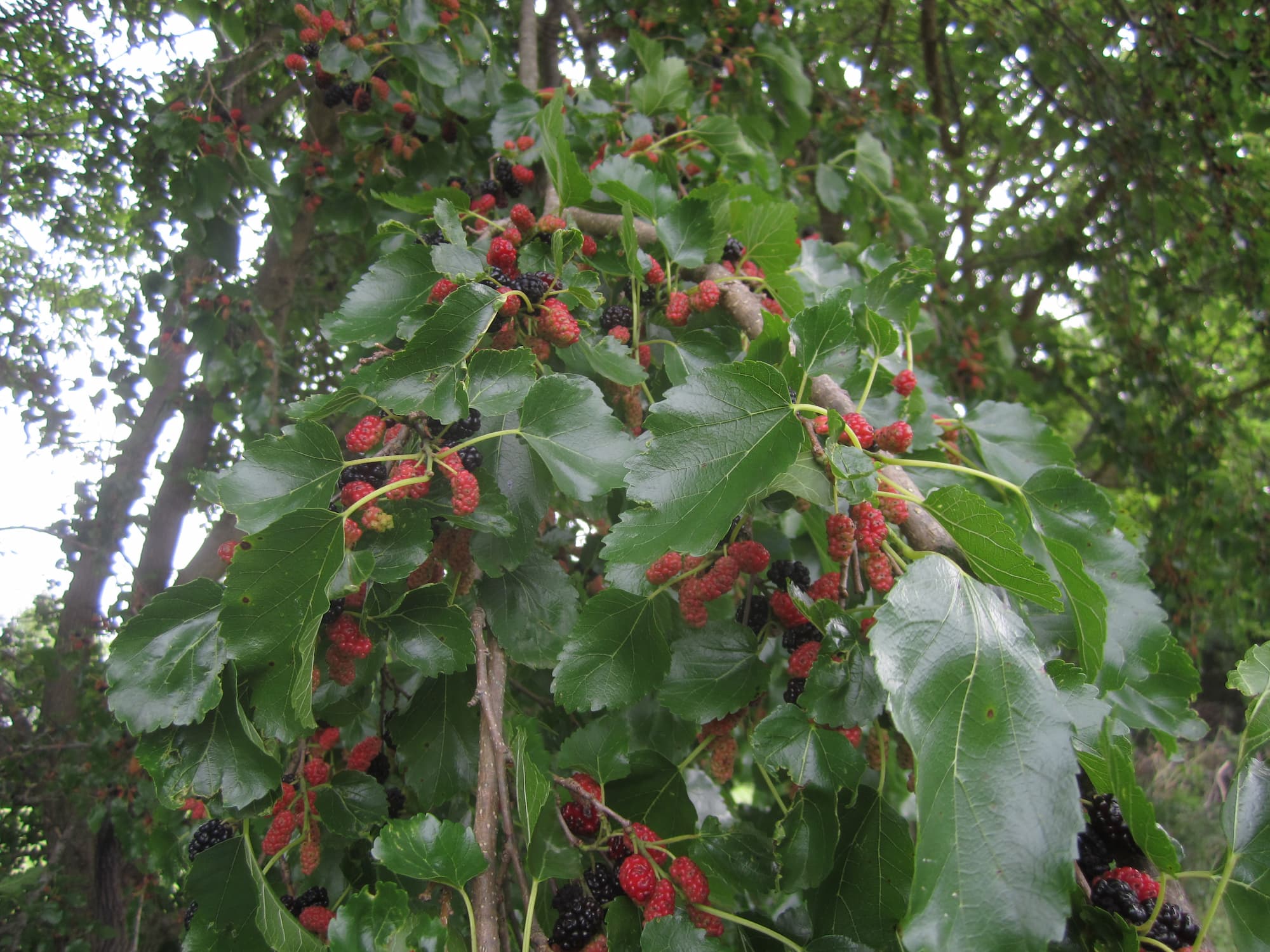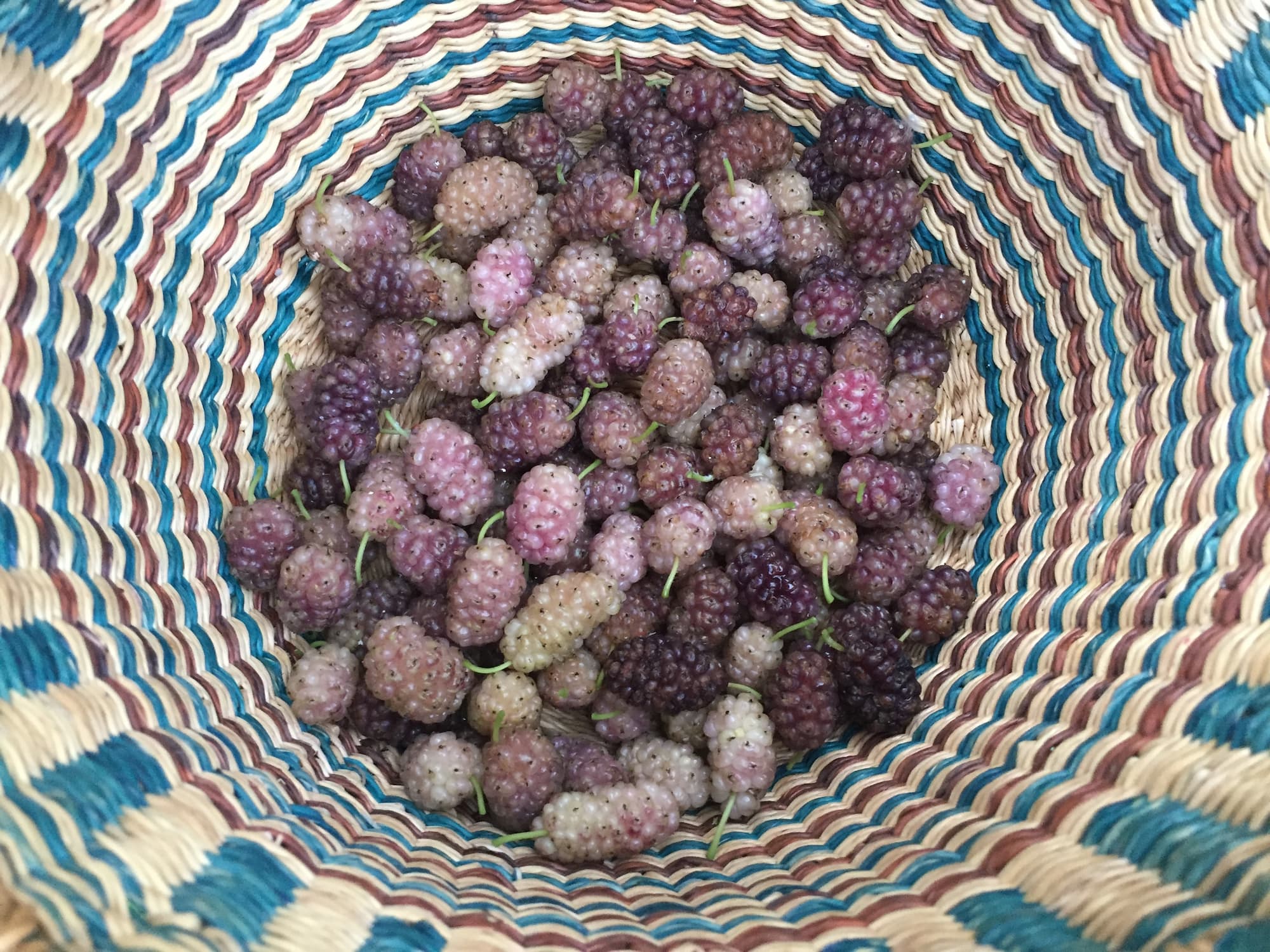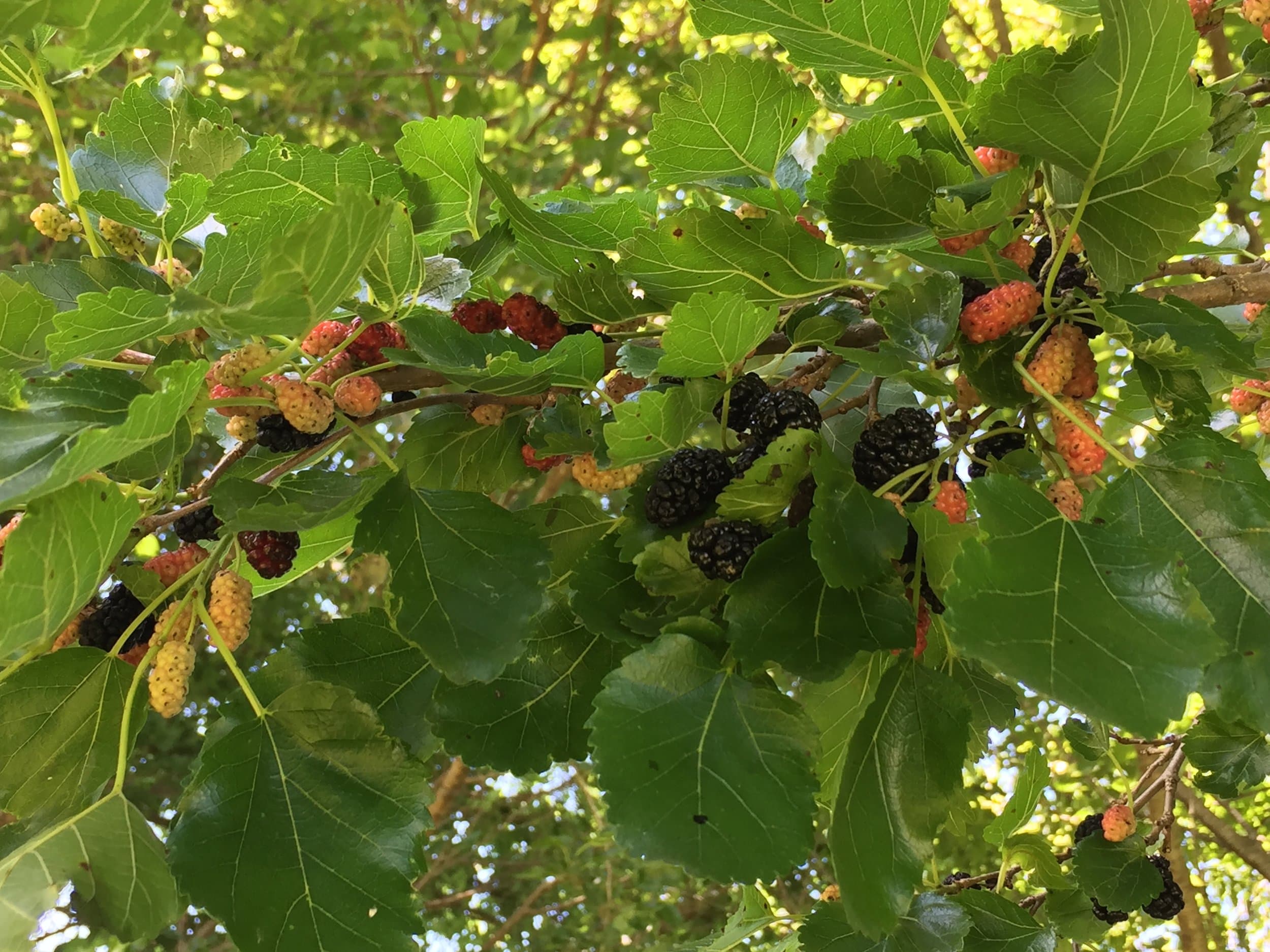How to Identify Mulberries — Foraging for Edible Wild Berries
- Authors
- Name
- Sam Sycamore
- @tanoaksam
- Published on
- Last updated
Table of Contents
- What are mulberries?
- Are mulberries edible?
- Key characteristics
- Etymology and taxonomy
- Common names
- Taxonomical lineage
- About the Morus genus
- Where to find mulberries
- When to gather mulberries
- Why forage for mulberries?
- How to harvest and prepare mulberries
- How to sustainably work with mulberries
- Mulberry lookalikes
- Blackberry
What are mulberries?
Mulberries are deciduous understory trees with worldwide distribution and a long history of human cultivation.
In North America we have two native species, the American (red) mulberry M. rubra of the East, and the Texas mulberry M. microphylla of the Southwest. Both are fairly uncommon due to the destruction of their habitats and the ease with which they hybridize with the more common introduced Asian (white) mulberry, M. alba.
Are mulberries edible?
Yes! Berries, leaves, and young shoots are edible.
Key characteristics
- deciduous tree with prolific blackberry-like fruits which may be purple-black, red, or white/pink/slightly translucent
- simple leaves with toothed margins which may be oval-shaped, mitten-shaped, or three-lobed
- M. alba likes full sun and is common in marginal or disturbed sites; M. rubra prefers shade and is much less common

Early in the season, a mulberry tree will be packed full of multicolored berries.
Etymology and taxonomy
Common names
Mulberries.
Taxonomical lineage
Source: Wikipedia
About the Morus genus
Note that white, red and black do not describe the colors of the berries produced by a given species, which has led to endless confusion among foragers and naturalists alike.
The species known as red and black mulberries produce purple-black fruits, while the species called white mulberry may ripen to red, purple, or white-pink — but white fruits are the least common. All mulberry species can hybridize.
In Incredible Wild Edibles (2017), Sam Thayer makes a case for replacing white and red with Asian and American, respectively, to put an end to the color confusion. We will follow this recommendation here. For our purposes we can treat all mulberries the same, but expect most if not all wild mulberries you encounter to be of the Asian variety.
Where to find mulberries
The American mulberry is considered somewhat threatened across its range in eastern and central North America and is not especially common. It is slow-growing and requires a fair amount of shade but can climb to 50 feet or taller when fully grown, so it generally needs more mature woodlands with an open understory to thrive. These habitats are increasingly rare, and when the niche disappears, the species disappears, too.
Most of us are far more likely to encounter the weedy exotic Morus alba from Asia than either of our native species. It can be found all throughout the United States.
The Asian mulberry does not love shade but grows vigorously in pretty much any marginal or disturbed rural sites you might come across, such as roadsides, fence lines, old farmland, and woodland edges.
Throughout urban and suburban America, Asian mulberries are commonly found growing out of sidewalk strips, tangled up in chain-link fences, and reaching out from the edges of yards and city parks.
M. alba has been domesticated for millennia in China, and widely cultivated throughout Europe and Asia primarily as food for silkworms.
White mulberries were introduced to North America in the 17th century with the intention of establishing a silk industry in the New World. The silkworms died out but the trees remained, and escaped cultivation soon after.

So-called 'white' mulberries often ripen to shades of pink-purple. These berries all came from the same tree.
When to gather mulberries
Mulberries fruit in June and July across most of their range. Berries are fully ripe when they readily fall from the branch without plucking.
Leaves and shoots are best when still young and tender early in the season, or anytime the tree sends up vigorous new stems.
Why forage for mulberries?
Asian mulberries are a highly abundant and sorely underutilized resource.
The average American who even knows what a mulberry is in this era will most likely complain about how its berries discolor her driveway or the hood of her car, and has probably never considered eating them!
If only someone had taught her to appreciate the countless pounds of delicious, nutritious fruit growing directly above her head, for free, with no cultivation necessary.
How to harvest and prepare mulberries
Taste several ripe berries from any given tree before harvesting in bulk, because the flavor can vary from "one of the best fruits on Earth" to "mushy, seedy water."
The simplest way to harvest is to lay a tarp or two down at the base of the tree and gently shake the branches or trunk, dropping all of the ripest berries to the ground where you can gather them up quickly and sort now or later.
Ripe mulberries are extremely fragile and perishable, so handle them gently and don't expect to be able to gather very many without smashing them up quite a bit.
In the kitchen, try using mulberries anywhere you might use blueberries, raspberries, or blackberries. Since they lack the tartness of comparable berries, you may want to blend them with any of the aforementioned fruits when making jams and jellies.
If you end up with a large quantity of berries with only decent flavor, consider making them into a wine. The final result can be quite rich and complex: the last batch I made reminded me of a sweet Port wine.
Mulberries are preserved most easily by freezing, but can also be smashed up and dried into fruit leather.
Greens and young shoots can be eaten raw or lightly sautéed. The flavor is very mild.

Ripe mulberries are often found waiting underneath leaves, where birds are less likely to grab them.
How to sustainably work with mulberries
For most, Asian mulberries are considered a weedy nuisance at best, and a direct threat to native biodiversity at worst.
As for their invasive status: the invasion of the Asian mulberry began hundreds of years ago, and at this point it is an inextricable fixture on the North American landscape. They are not retreating anytime soon, nor will they ever be eradicated, in my opinion.
That said, there is a case to be made for the preservation of what's left of our native American mulberry, so if you live somewhere that boasts a population of M. rubra, you'd be doing your local ecosystem a favor by removing any nearby Asian mulberries.
M. alba is generally disliked by land managers because it tends to grow quickly and in a sprawling habit, meaning its large, weak branches are prone to breaking. Keep this in mind if you intend to actively manage Asian mulberries on your land.
As with most questions of land management, handling Asian mulberries forces us to really ask why: for what reasons are we deliberately interfering in the natural cycles and rhythms already in motion? What kind of impact will our actions have?
If our reasoning amounts to "kill the invasive species because invasive species are bad and need to be killed," then I would argue that we've lost sight of the bigger picture, or else we severely overestimate what we're capable of. The impact of cutting down a dozen invasive trees found on a handful of acres is essentially nil, and the resources and energy invested could be put to use much more effectively elsewhere.
Do what you can to protect the American mulberry wherever you may encounter it, but don't hesitate to make the most of the gifts of abundance provided by its invasive counterpart. Even with my somewhat laissez-faire approach, I would not attempt to cultivate wild Asian mulberries, if only because the domesticated and improved cultivars out there are so much more delicious, and not at al difficult to grow when purchased from a nursery.
There are a wide range of cultivars out there if you are interested in growing your own. Cultivated mulberries are generally derived from M. alba or else M. nigra, the black mulberry, which is native to Persia and rare to find growing wild in North America. But remember the Morus genus's love of hybridizing if you plan to plant your own trees, and be sure to deal with any nearby Asian specimens accordingly.
Mulberry lookalikes
Blackberry
The only berry that resembles a mulberry is a blackberry (Rubus spp.), but blackberries grow in thickets of thorny canes, not on trees, and are present much later in the season.
 canes can grow large, but never as large as a tree—and the thorns are a dead giveaway. Still, not a bad find!](/static/images/plant-photos/brambleberries/brambleberries-blackberries.jpeg)
[Blackberry](/plants/wild-raspberries-blackberries-edible/) canes can grow large, but never as large as a tree—and the thorns are a dead giveaway. Still, not a bad find!
Click here to learn more about wild blackberries and related species.
Foraging North America
Did you find this article helpful?
This is an excerpt from Foraging North America: The Botany, Taxonomy and Ecology of Edible Wild Plants.
Foraging North America is a 12-week crash course designed to arm you with a functional working knowledge of botany and taxonomy that you can take with you out onto the land to fast-track the ID process and boost your confidence when gathering wild foods for the first (or five-hundredth!) time.
You'll get a practical education in ecological literacy by applying the ethos of conservation through use—the (surprisingly) radical notion that humans can, in fact, have a positive impact on the environments that we move through.
Food is everywhere—you just need to know what to look for!